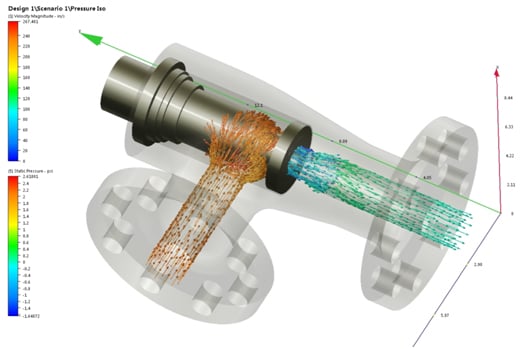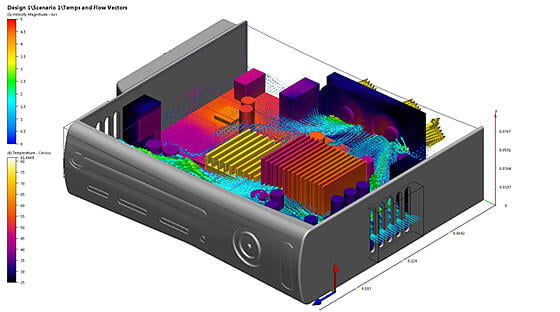In keeping with their overall strategy to “democratize” design software, Autodesk has made significant changes to the way its newest Simulation offerings can be acquired and put to use. This is especially true of Simulation CFD, which is now available in both a ‘cloud solver only’ form and a combination of cloud and local solvers.
The introduction of the cloud solver has also provided some new licensing models that dramatically lower the cost while providing more flexibility. You can now license and use Simulation CFD 360 in a way that best meets your needs. In the remainder of this article I’ll explain how the cloud solver works, and why you might want to take advantage of this fantastic new technology.
What is Simulation CFD?
Before we get into the specifics of the cloud solver, let’s start with a brief explanation of Simulation CFD and its capabilities. The CFD in this case stands for Computational Fluid Dynamics. Simulation CFD is a general analysis package that allows you to solve a range of both fluid flow and thermal problems. Some of the core capabilities are:
- Steady State and Transient Flow
- Steady State and Transient Heat Transfer
- Forced and Natural Convection Heat Transfer Analyses
Simulation CFD can be used to determine anything from the pressure drop across a choke valve to the shockwave of an object breaking the sound barrier to the temperature distribution in a building. While in the past such technology was difficult to use and incredibly expensive, today’s solutions are both economical and simple enough that even a casual user can apply them to great effect.
 (Caption: You can use Simulation CFD to optimize diffuser displacement and air returns, ensuring nobody gets cold feet!)
(Caption: You can use Simulation CFD to optimize diffuser displacement and air returns, ensuring nobody gets cold feet!)
How Does the Cloud Solver Work?
While CFD software is nothing new, leveraging the power of cloud computing for simulation is a more recent development. No longer are you required to dedicate one or more expensive workstations simply to crunching numbers. Now you can take advantage of the scalability, power, and ever-presence of the cloud to solve design problems faster, at less expense, and with better results than ever before.
Simulation CFD 360 still uses a desktop client to both set up models for solution and to review results. It works just like the traditional (local solve) version of Simulation CFD – you just direct the software to the cloud to do the math. The relevant data is then packaged and sent to an Autodesk server for analysis.
You can even receive the results back in real-time, just like if you were solving locally. If you’d rather do something a bit more productive, however, you can close the software – even shut down your computer – and download the results later. You’ll even get an email when the solution is complete so you know when to check back.
And the best part is that Simulation CFD 360 is available anywhere you have an internet connection. You could start the analysis before you leave the office, go have a nice dinner with the family, and review completed results on your desktop at home. Log in from anywhere and get what you need.
(Caption: I can avoid the Red Ring of Death while at the beach? Sign me up!)
Why Should I Solve in the Cloud?
So now you know the basic mechanics of how the cloud solver works. But why is it better than traditional local solving?
You might think that the solutions run faster because of cloud parallelism, but that’s not strictly the case. While the machines Autodesk uses to run the solutions are powerful, they’re akin to a CAD workstation you might already have in your office. You benefit by having the ability to run multiple solutions simultaneously.
With traditional local solvers (the Simulation CFD Local Solve option included), a single solver license can only crunch on one solution at a time. If you need to run multiple models, each model gets in line:

Once you get your first solution, you can then start on your second model, and so on. Where Simulation CFD 360 shines is in its ability to run as many models as you need all at once:

In the above example, if each model takes four hours to run, you can be ready to compare results across all three with Simulation CFD 360 in…four hours. With traditional local solving, you’ll need at least 12 hours. If you have a design review tomorrow, you’re not going to get much sleep if you’re not using Simulation CFD 360!
The other major benefits of solving in the cloud are value and flexibility. Autodesk licenses Simulation 360 on a yearly basis, without the typical huge up-front software cost. Need simulation only for a short term? Buy a limited license, where each solution uses credits. If you misjudged, you can always buy more. Need it for a longer term? Buy an unlimited license, and you can run as many solutions as you’d like for an entire year. At the end of the year term, you can decide if you still need it. If not, just walk away, without worrying about the loss of a huge up-front expenditure.
One thing to keep in mind about the cloud solver is that all result data needs to be downloaded from Autodesk’s servers to your local machine for review. For some transient CFD analyses, result sets can reach gigabytes in size. If you have a low bandwidth connection this can obviously take quite some time.
If this applies to you, don’t worry – Autodesk now offers Simulation 360 Pro with Local Solve. With this option, you can send your analysis to the cloud or run the solution locally. This gives you the ultimate in flexibility.

(Caption: Whether you need to solve one problem a month or several a day, Autodesk has you covered)
The Future of Simulation is in the Cloud
It seems like everywhere you turn these days, someone is talking about the cloud. Thanks to cloud overload, it can be easy to overlook a technology that actually provides significant benefit when used in this way. Simulation is the perfect technology to take advantage of ever-growing cloud capability. The massive parallelism it offers can help you solve design challenges quickly, while its economic scalability allows software vendors to provide functionality at historically miniscule prices. Autodesk Simulation CFD 360 is the perfect example of this – power, flexibility, and value all in one package.
If you have any need for fluid or thermal analysis in your digital prototyping or BIM workflow, you definitely need to check this product out.




Comments